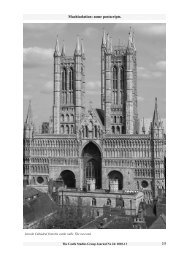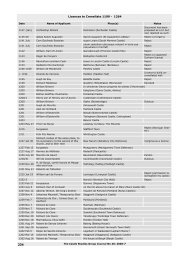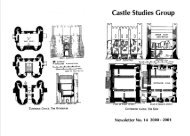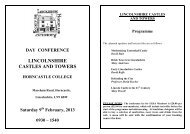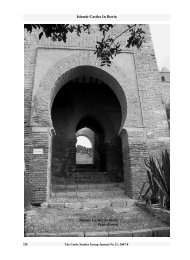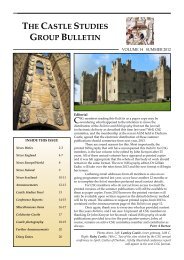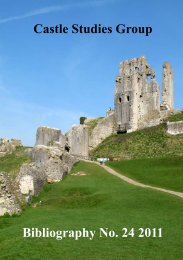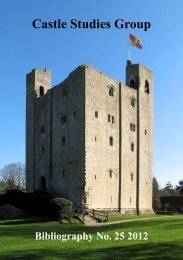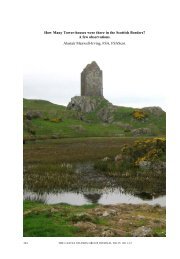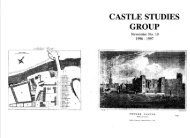Castle Studies Group Bibliography No. 22 2009
Castle Studies Group Bibliography No. 22 2009
Castle Studies Group Bibliography No. 22 2009
You also want an ePaper? Increase the reach of your titles
YUMPU automatically turns print PDFs into web optimized ePapers that Google loves.
while interesting aspects from the television series are covered in picture captions, for example,the dating of the wooden doors at Hay on Wye <strong>Castle</strong> p. 295), which surely is in Breconshire,not Radnorshire.I will cover the final book under ‘Individual sites – England’, namely Terry Wardle’s(unprovable) suggestion that the site at Burghill, north-west of Hereford, is where England’sfirst castle was built, before the <strong>No</strong>rman Conquest.General ArticlesRetaining the alphabetical sequence of authors, we begin with the late Richard Avent’spresidential address to the Cambrian Archaeological Association, delivered a few weeks beforehis tragic death in 2006. The paper was published earlier this year in the volume ofArchaeologia Cambrensis for 2007. Readers might like to know that on p. vi of the volume,before Richard’s paper, there is a picture of the memorial arbour dedicated to Richard’s memoryat Laugharne <strong>Castle</strong>, the circular base of which incorporates stones from castles throughoutWales.Richard’s address to the Cambrians examined the restoration of castles in Wales as ruins,the philosophy and practice behind such schemes. It is a development of his paper on the earlywork done on Caernarfon, in the nineteenth and early twentieth centuries, published in the AnnHamlin Festschrift (see <strong>Bibliography</strong> 19). <strong>Castle</strong>s covered by Richard include Dolwyddelan andManorbier, and there is an interesting account of the work undertaken at Caerphilly in the 1920sand 1930s by the fourth marquess of Bute, and the correspondence that ensued, particularlyresulting from the visit to the castle by the Inspector of Ancient Monuments for Wales, RaleghRadford, in the company of Cyril Fox, Director of the National Museum of Wales.A paper close to my heart, mirroring my contribution to the David Sweetman Festschriftedited by Con Manning (see <strong>Bibliography</strong> 21, p. 23), is Terry Barry’s bibliographic survey ofthe study of medieval Irish castles. The article is in the new format of Section C of the RoyalIrish Academy’s Proceedings, and the author stresses that, as in Britain, castles studies areincreasingly being integrated into the wider picture of medieval settlement. The paper is dividedinto various sections, one of which is on castle ringworks, an area of great debate still in Ireland(note that Barker’s and Higham’s Christian names have been transposed here).In an issue of English Heritage members’ magazine Heritage Today Tracy Borman’s article,‘Privy’s progress’, examines the humble lavatory, citing a number of examples from EH sites ofall periods. Illustrations include those at the castles of Middleham and Orford, several examplesfrom the latter being shown.The National Museum of Wales has missed out on a number of issues of the Europa <strong>No</strong>straScientific Bulletin. In issue 61 for 2007 (mis-numbered on the title page, reading 60 (2006))Jonathan Coad looks at the nineteenth-century revival of military symbolism in the architectureof the period, ranging from Castell Coch to the Victorian forts.The theme of English Heritage’s Conservation Bulletin no. 58 was ‘Presenting historicplaces’, and rather than look at various relevant pieces by author and scattered through thissection, I will consider the issue itself. It is of interest in the light of the recent programme ofEH’s work at Kenilworth <strong>Castle</strong> and the forthcoming conference in London on the recent workat Dover. Bearing in mind the work of Historic Royal Palaces at the Tower of London and the‘creation’ of royal apartments in the late thirteenth-century style, I suppose that it was only to be4



